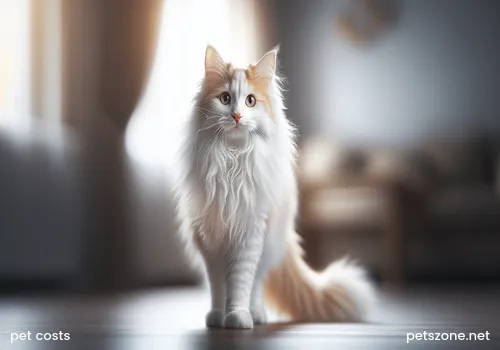Big Difference in Costs of Raising Cats and Dogs_Comparing the Costs of Raising Cats and Dogs
In China, raising pets has become a trend, and the status of fur children is getting higher and higher. Some even joke that "people eat from Pinduoduo, and pets eat Michelin." But raising pets is not just about feeding and cleaning up — there is a considerable cost behind it. So, which is more "money-burning," raising cats or dogs? This is a dilemma for many pet enthusiasts.

Overall, the average cost of raising dogs is generally higher than that of cats. This is mainly because dogs are usually larger than cats, eat more, require more activity space, and generally need more frequent walks and grooming. Of course, "raising pets in poverty or wealth," the specific costs vary greatly depending on the pet’s breed, size, age, and the owner's raising methods.
Where Does the Money Go When Raising Cats and Dogs?
Whether raising cats or dogs, the main expenses can be divided into several categories: initial costs, food expenses, medical and health care costs, daily supplies, and other miscellaneous fees.
1. Initial Costs: The "Welcome Gift" for New Members
When you decide to bring a furry little member home, the first thing is to prepare a one-time initial cost. This money is mainly spent on the following aspects:
- Pet sourcing fees: If adopting instead of buying, this cost may be lower or even free (some organizations charge small registration or vaccination fees). If buying from pet stores or breeders, purebred cats and dogs can be expensive, ranging from hundreds to tens of thousands of yuan, or even higher.
- Vaccinations and deworming: Young cats and dogs need multiple vaccines and internal and external deworming—a necessary health investment.
- Spaying/neutering surgery: Neutering helps pet health and behavior management. Costs vary by pet gender, size, and veterinary clinic; female cats and dogs usually cost more than males.
- Basic supplies: Dog bowls, cat bowls, dog leashes, litter boxes, scratching boards, beds, cages, etc., are essential to settle the pet.
Comparison: Generally, basic supplies for dogs, especially large breeds’ leashes and beds, tend to be larger and more expensive than those for cats.
2. Food Costs: Food is the primary need, even for pets
Food is a major part of daily pet expenses. Food costs mainly include staple food, snacks, canned food, and supplements.
- Staple food: Cat food and dog food prices vary greatly depending on brand, quality, and ingredients. Generally, larger dogs eat more, so dog food costs tend to be higher than cat food.
- Snacks and canned food: These improve diet or serve as training rewards. Spending varies by owner; some invest heavily in snacks, canned food, or even homemade fresh food.
- Nutrition supplements: Depending on pet health, extra supplements such as fish oil and joint aids may be needed.
Comparison: Due to size and appetite, dogs are usually considered big eaters, with food costs generally higher than cats.
3. Medical and Health Care Costs: Health is priceless, but medical care is charged
Pets, like humans, get sick and need regular check-ups and vaccinations. Veterinary costs are a significant unpredictable factor and often a sore spot for many pet owners.
- Vaccinations and deworming: Adult cats and dogs also require regular vaccinations and deworming beyond the juvenile period.
- Annual check-ups: Regular checks help early detection of health issues and prevention.
- Illness treatment: If a pet gets sick or injured, medical bills can be very high—minor ailments costing hundreds to thousands, major illness possibly tens of thousands. Surgery, hospitalization, and special exams (CT, MRI) are especially expensive.
- Pet insurance: To cover high medical costs, some owners buy pet insurance but should pay attention to coverage and terms.
Comparison: Although cats can face high medical costs, due to the larger size of some dogs and breed-specific susceptibilities, dogs may have higher potential medical expenses.
4. Daily Supplies and Grooming: Keeping Pets Neat and Charming
Besides food and health care, pets need various daily supplies to maintain quality of life.
- Litter: Essential for cats and must be replaced regularly.
- Cleaning supplies: Pet shampoos, combs, nail clippers, etc.
- Toys: Provide entertainment and expend energy.
- Grooming: Especially long-haired cats and dogs need regular brushing, bathing, and hair trimming. Some owners choose professional pet grooming salons.
Comparison: Dogs usually have higher grooming needs than cats, especially breeds requiring regular trims.
5. Other Miscellaneous Expenses: Unexpected Costs
Pet ownership also entails some less fixed but possible expenses.
- Boarding fees: When owners travel and cannot bring pets, they need to board them at pet stores or find someone to care for them.
- Smart devices: Smart feeders, smart litter boxes, pet monitors, though not essential, enhance convenience.
- Training costs: Especially for dogs, behavioral training may be needed.
- Accidental expenses: Pets may damage furniture or items, incurring repair or replacement costs.
- Pet services: Extra services like pet photography, pet spa, are considered luxury consumption.
Comparison: Dogs may require more outdoor activities and training, resulting in higher associated costs than cats.
Cost Showdown Between Raising Cats and Dogs: Who is the True "Money Burner"?
Overall, dog-raising costs usually exceed cat-raising expenses. Multiple reports and surveys show that the annual average spending per dog is higher than per cat. For example, a 2021 report indicated annual dog expenses of about 2634 yuan versus about 1826 yuan for cats. Data from 2023-2024 shows average annual spending of 2875 yuan for dogs and 1870 yuan for cats. A survey targeting the Peruvian market also indicates dogs spend significantly more on food and toys than cats.
Of course, this is an average; specific costs depend on many factors.
- Size: Large dogs have greater food, medication, and space needs, naturally costing more.
- Breed: Purebreds may have higher initial purchase costs and breed-specific health issues that increase medical costs.
- Raising method: Owners pursuing "fine raising" with premium food, frequent grooming, and smart devices will also raise costs significantly.
- Health status: Healthy pets with fewer illnesses save on medical expenses.
In general, raising cats is relatively more economical and suitable for people with limited living space, less time, or tighter budgets. Cats are independent, do not need frequent walks, and can play happily at home. Raising dogs requires more time and effort for companionship, training, and walks, and has higher space requirements. Of course, whether raising cats or dogs, owners need to invest love, patience, and responsibility to ensure their pets grow healthy and happy. After all, the emotional value they bring is priceless.
Frequently Asked Questions
- How much does it cost to raise a cat for one year?
Basic expenses for raising a cat for one year range from a few thousand to ten thousand yuan. Costs may be higher for quality-focused lifestyles or illness. - How much does it cost to raise a dog for one year?
The cost of raising a dog for one year is usually higher than that of a cat, roughly from a few thousand to twenty thousand yuan or more, depending on size, breed, and raising methods. - Which is easier to raise, cats or dogs?
Generally, cats are relatively more independent, require less space, and do not need frequent outdoor activities, suitable for fast-paced life or limited space. Dogs need more companionship, training, and outdoor activities. The choice depends on personal lifestyle and preferences. - Why is pet medical care so expensive?
Pet medical services are mostly private and lack insurance systems; pets cannot communicate verbally, requiring diagnostic equipment. These factors contribute to high costs.

-560x560.webp)



